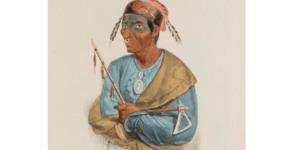Monoquet (Potawatomi chief) facts for kids
Quick facts for kids
Chief
Monoquet
Of The Tippecanoe River
|
|
|---|---|
 |
|
| Born | c. 1775 |
| Died | c. Spring 1836 Monoquet Village, Kosciusko County, Indiana
|
| Cause of death | Suspected poisoning |
| Military career | |
| Rank | Chief of the Tippecanoe River |
| Battles/wars | Battle of Tippecanoe |
Chief Monoquet (or Muh-neck-o-it) also known as: Menoga, Minoquet, Menucquett, Menoquet, Manquett (c. 1775) was a Native American Chief within the Potawatomi tribe in Indiana during the 19th century. He's said to have become a young warrior around the age of 15, and was the most influential chiefs of the five that were residing in Kosciusko County when white people started settling in the county in 1832. His birth date is unknown but in 1835 was estimated to be 60 years old, making his estimated birth year 1775.
Appearance
Around 1835, William C. Graves, an early resident of the local town of Leesburg, IN (also the first school teacher of the same town and Kosciusko county) took it upon himself to leave a record of the current Indian chiefs of Kosciusko before their removal soon after.
Below is a quote from his description:
In 1836 Chief Monoquet was about sixty years of age, a rather spare man above the medium height, of a dark color, high forehead, small bright eyes, aquiline nose and stern countenance, and looking as though he inherited all the antipathy of his race to the whites.
His village
His village was located over three acres of land along the north bank of the Tippecanoe River at IN-15 N and Monoquet Road in Kosciusko County, Indiana. The land during his time contained about fifteen bark-covered wigwams scattered randomly over the land.
Migration to Kansas
The Native Americans of Kosciusko County were eventually forced to migrate to Kansas. Chief Monoquet died before his band was forcibly removed.
Mysterious death
His death was attributed to poisoning which tribesmen thought was given to him by a Native American woman who had been visiting from Michigan.
It is said that Monoquet died of lung fever as the result of a prolonged debauch. At the time a handsome young squaw from some tribe in Michigan was on a visit to his village, and, on account of the sudden death of the chief the woman, to whom it is believed he had been attentive, was suspected by certain members of the tribe to have poisoned him. The rumor, reaching her ears, threw her into a panic of fear and she started on foot alone for her Michigan home. Her flight but confirmed the suspicions of the tribe and two young braves were sent in pursuit of the fugitive. One of the warriors overtook her at the crossroads south of Leesburg and struck her with his tomahawk. Two early settlers who were coming down the road, Joseph Harper and Harrison Pool, witnessed the cowardly murder, and approached the two Indian braves. One of the Indians flourished his tomahawk and exclaimed exultantly "Waugh! Big Indian me". Mr. Harper, the plain white man, replied: "Yes, big Indian you, to run down and brain a defenseless squaw!" Then raising his gun, he added: "For a fip I'd put a bullet through your cowardly heart." But the Indians sneaked off to seek a more appreciative audience.

